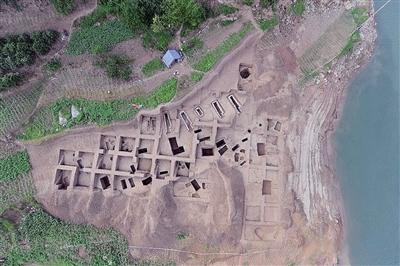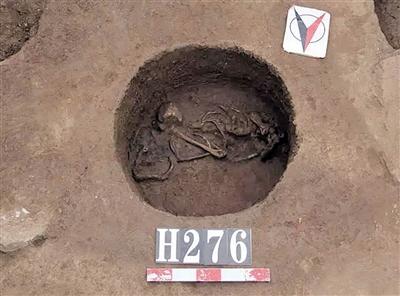First tomb unearthed in tombs of the daxi culture with burn marks curled down
 Formula Wu Shanda paddy field aerial photograph of the site. (Municipal Institute for cultural heritage)
Formula Wu Shanda paddy field aerial photograph of the site. (Municipal Institute for cultural heritage)
Daxi culture burials by fire.
Rounded pit Tomb, Tomb lie curled up body, in the soil beneath him, differently presented signs of fire, are clearly visible. Yesterday, the message from the municipal Research Institute of cultural heritage, first with fire to the traces of the daxi culture, wushan County unearthed the paddy field in our city.
What tomb after death his body was burning? In addition to the usual ceramic funerary objects, a funerary objects unearthed in the ruins of what? Tian archaeological site daiyubiao, head of wushan County answer one by one.
Use of drones, some bone identification
Rotary wing unmanned aerial vehicle circled around in the air, from a different angle and a riverside terrace, spans more than 5,000 years of the tombs, are being revealed one by one.
Tombs, more than 5,000 years ago, the remains of the deceased are crouched body side.
This is paddy archaeological sites of wushan County, located in wushan County, Chongqing City, Colt Xiang Wu Bai San, representation of the daxi culture relics in the reservoir area in Chongqing is located in daxi sites and between hospital sites.
Daiyubiao said, big paddy site is located in three Gorges reservoir elimination fell district, 2013 in heritage security inspections Shi was found; March 2014 to September, City Culture Heritage Institute on the site carried out has rescue sex archaeological excavations, total completed excavations area 1300 square meters, found Tahiti culture, and business week, and zhanguozhong late to Han early, and dynasties, and Tang song remains more than 470 more than at, which gray pit 211 seat, and tombs 258 seat, and room site 1 seat, and ditch 3 article, unearthed pottery, and stone, and jade, and porcelain, and copper, and iron, and Small pieces of bone artifacts more than 1700 pieces (sets).
In March this year, municipal Research Institute of cultural heritage has once again started excavations on the site were found in the Neolithic (daxi culture), late zhanguozhong to the early Western Han dynasty, Song dynasty, Ming and Qing dynasty relic 175, which pits 118 seats, 53 tombs, Channel 4, unearthed pottery, stone, ceramic, copper, iron, bone artifacts and specimens of more than 500 pieces (sets).
This time, archaeological experts not only use the rotor UAV filming site environment, human bone identification, such as a comprehensive collection and recording of archaeological information, and the overall removal of daxi culture burials of well preserved archaeological laboratory.
Why a fire trail is a mystery
In the sites over more than 200 tombs of the daxi culture, there is a circular burial is very different, in part of the Tomb remains near the end of the Tomb, there was a glowing red soil.
Daiyubiao said that after careful excavation and analysis of soil as well as the identification of the bones, they found that the end of this tomb, the soil and the remains of the Tomb there are traces of fire.
The past, archaeologists are not found in tombs of the daxi culture have the custom of burning, why this tomb is there such a special case, is it because the Tomb special status?
Daiyubiao said that in this round and no funerary objects were found in the grave, tomb burial posture also has no special place, so their status should, like other owners of the tombs. And if the fire was the daxi people's funeral customs, not only the tombs appear red soil and fire signs. At present, can only be concluded that, the tomb is not a natural death, in other words, it may be because they have a disease and died, so the daxi people the special treatment of the bodies were burned.
But what is the answer? Further archaeological excavation and research.
What tools do they use make beads?
Tombs of the daxi culture in General, and other funerary objects other than ceramics, materials, and accessories made with clam shell is also a common word, in large paddy field site of two tombs of wushan County, archaeologists have found hundreds of black slate of the rare pearls.
Daiyubiao said their location was found, close to the tomb of the head and neck or wrists.
Most of these beads of black slate with mung bean size, about two millimetres high, a small hole in the Middle, is a flat circular cylindrical, reflecting high levels of processing of the daxi culture ancestors.
Daiyubiao said in Grand Rapids in the late Neolithic, and what tools do what these beads are chipped and with what tools drill holes, is unknown.
During the archaeological excavations, archaeological experts have also identified a large paddy field site distribution range of the daxi culture. Meanwhile, groups were found in this area in Yuxi upper xiajiadian culture advanced daxi culture and later coexistence between the two archaeological relics, is to explore the important relationship between the two materials, to determine the era of Yuxi's top culture provided new evidence. Our reporter Li Sheng
(Editors: Biao Guo UN832)
2016-10-22 05:14:10
Chongqing morning post
首座带有火烧痕迹的大溪文化墓葬出土 墓主人蜷身卧倒
 公式巫山大水田遗址航拍图。 (市文化遗产研究院供图)
公式巫山大水田遗址航拍图。 (市文化遗产研究院供图)
被火烧过的大溪文化墓葬。
圆形的土坑墓内,墓主人蜷身而卧,他身下的土层中,与众不同地呈现出了被火焚烧过的痕迹,清晰可见。昨天,来自市文化遗产研究院的消息,首座拥有火烧痕迹的大溪文化墓葬,在我市巫山县大水田遗址出土。
究竟是什么原因让墓主人死后尸体被焚烧?除了常见的陶制随葬品外,这个遗址里还出土了哪些随葬品?巫山县大水田遗址考古现场负责人代玉彪一一揭开谜底。
动用无人机,还有人骨鉴定
多旋翼无人机在空中盘旋,从不同角度拍摄着这片临江台地,一个个跨越了5000多年的墓葬,正在被逐一揭露。
墓葬中,5000多年前的逝者遗骸大多蜷曲着身体,安然侧卧。
这就是巫山县大水田遗址现场,它位于重庆市巫山县曲尺乡伍柏村三社,地处重庆库区大溪文化的代表性遗存大溪遗址和人民医院遗址之间。
代玉彪说,大水田遗址地处三峡水库消落区,2013年在文物安全巡查时被发现;2014年3月至9月,市文化遗产研究院对该遗址开展了抢救性考古发掘,共完成发掘面积1300平方米,发现大溪文化、商周、战国中晚期至西汉早期、六朝、唐宋遗迹470余处,其中灰坑211座、墓葬258座、房址1座、沟3条,出土陶、石、玉、瓷、铜、铁、骨质器物小件1700余件(套)。
今年3月,市文化遗产研究院再次启动了对该遗址的发掘工作,共发现新石器(大溪文化)、战国中晚期至西汉早期、宋代、明清遗迹175处,其中灰坑118座、墓葬53座、沟4条,出土陶、石、瓷、铜、铁、骨质器物标本500余件(套)。
这次,考古专家们不仅使用了多旋翼无人机拍摄遗址周边环境、人骨现场鉴定等全面收集和记录考古信息,还对整体切割保存较好的大溪文化墓葬进行了实验室考古。
为何有火烧痕迹还是个谜
在遗址里200余座大溪文化墓葬中,有一座圆形的墓葬显得格外不同,在墓主人遗骸靠近墓底部分,有一片泛着红色的土面。
代玉彪说,经过仔细的现场发掘和对土层以及骸骨的鉴定,他们发现,这片墓底的泥土和墓主人的遗骸有被火焚烧过的痕迹。
过去,考古工作者们并没有发现过大溪文化墓葬有火烧的习俗,为什么这座墓葬会出现这样的特例呢,难道是因为墓主人身份特殊?
代玉彪说,在这座圆形墓坑中并没有发现任何随葬品,墓主人的入葬姿势也无特殊之处,因此,其身份应该与其他墓葬的主人一样。而且如果火烧是当时大溪人的丧葬习俗,不会单单只有这座墓葬才会出现红色土面和火烧迹象。目前,只能初步推断,墓主人并不是正常死亡,也就是说,其可能是因为患有某种疾病而死,因此当时的大溪人才对遗体进行了火烧的特殊处理方式。
但谜底究竟是什么?还有待进一步考古发掘和研究。
他们用什么工具打制了珠饰?
在一般的大溪文化墓葬中,除了陶制的随葬品之外,就近取材,用蚌壳制作的饰物也是常见的随葬品,可在巫山县大水田遗址两座墓葬中,考古工作者们却发现了数百颗罕见的黑色板岩珠饰。
代玉彪说,它们被发现的位置,都在墓主人的头颈部或手腕附近。
这些黑色板岩珠饰大多与绿豆一般大,高约两毫米,中间有小孔,呈扁圆形的圆柱体状,体现出了大溪文化先民高超的工艺加工水平。
代玉彪说,处于新石器时代晚期的大溪人,究竟是用什么工具打制了这些珠饰,又是用什么工具钻孔洞,目前还不得而知。
在这次考古发掘中,考古专家们还确定了大水田遗址大溪文化墓葬的分布范围。同时,在本次发掘区还发现多组玉溪上层文化晚期与大溪文化晚期两个考古学文化遗存之间的共存关系,是探讨二者之间关系的重要实物资料,也为确定玉溪上层文化的年代提供了新的证据。本报记者 李晟
(责任编辑:郭彪 UN832)
2016-10-22 05:14:10
重庆晨报